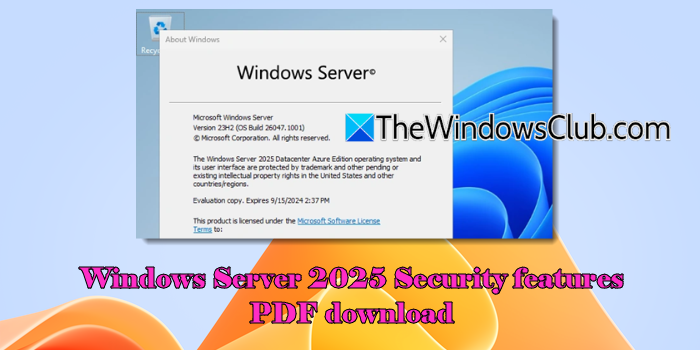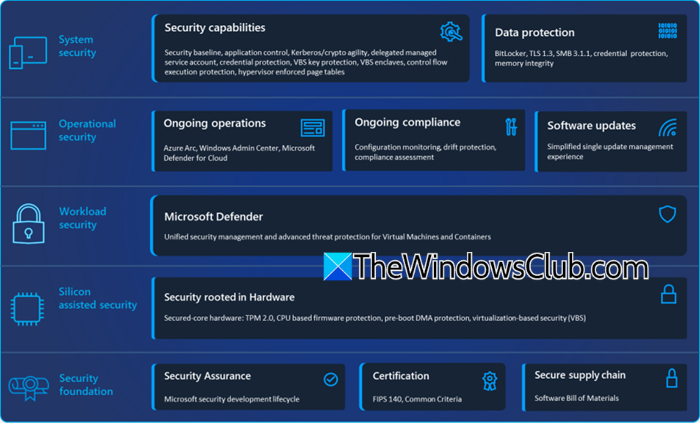Soon after announcing the general availability of Windows Server 2025, Microsoft released a Windows Server 2025 Security features PDF covering how Windows Server and related Azure security capabilities use a multifaceted approach to help protect organizations from existing and emerging threats. Read this post to learn about the key features of this PDF and how to download it for free.

Windows Server 2025 Security features PDF download
Windows Server 2025 is designed to help IT administrators better understand different layers of protection embedded in Windows Server. By reading the PDF, they can layer their approach to security to meet their specific needs, safeguarding their systems from advanced and frequent cyber threats including ransomware, nation-state attacks, and targeted breaches.
Key features and capabilities of Windows Server 2025

The following key capabilities of Microsoft Windows Server 2025 have been covered in the PDF guide:
System security: This section covers security baseline and best practices, use of secure protocols and cryptographic standards, application control, credential protection (leveraging Virtualization-Based Security (VBS) and TPM cryptography), Delegated Managed Service Account (DMSA), memory integrity protection, data protection (both at rest and in transit), network security, Hypervisor-enforced Paging Translation (HVPT), Kerberos enhancements, and more.
Operational security: This section covers ongoing operations, ongoing compliance, and software updates. It emphasizes the use of the Windows Admin Center
and Microsoft Defender for Cloud for operating Windows Server in a more secure manner.
Workload security: This section covers unified security management and advanced threat protection features for Virtual Machines and Containers. It highlights the role of Microsoft Defender for Cloud in detecting real-time threats such as malware, raising security alerts, and providing recommendations to remediate attacks.
Silicon-assisted security: This section covers secured-core capabilities, explaining how secured-core servers seamlessly integrate with Microsoft’s security offerings to not only identify but also help prevent real-world attacks.
Security Foundation: This section outlines Microsoft’s commitment to continuously investing in improving its software development process by building highly secure software and addressing security compliance requirements.
Overall, with the mainstream support for Windows Server 2025 ending in October 2029 and extended support lasting until October 2034, the security strategies and practices outlined in the guide will remain useful for up to a decade for IT professionals managing the latest edition of Windows Server in on-premises, hybrid, or cloud-based environments.
Download free Windows Server 2025 Security features PDF
You can download the Windows Server 2025 Security features PDF (free of cost) directly from Microsoft using this link. The PDF spans 19 pages split up into eight chapters. Each chapter covers in-depth information on security capabilities integrated within different layers of protection in Windows Server 2025, helping you build a secure server environment aligned with Microsoft’s latest recommendations.
I hope you find this useful.
Read: Download Windows Server 2025 ISO file.
What is the security feature of Windows Server?
Windows Server 2025 delivers enhanced security features to help protect enterprise environments against various threats. These include Credential Guard (protects sensitive credential information from isolating it in a secure virtual container), Windows Local Administrator Password Solution (automates the management of local administrator passwords on domain-joined computers), Network ATC (streamlines the deployment and management of network configurations for Windows Server 2025 clusters) and more.
Does Windows Server 2025 require TPM?
TPM is not strictly required to run Windows Server 2025. However, TPM 2.0 is highly recommended for new physical servers to support modern security standards. TPM enforces security by ensuring secure boot processes, protecting credentials, and facilitating other advanced security features, such as Credential Guard and Virtualization-based security.
Read: Windows Server 2016 Editions, Features, Guides, Tuning Tips.